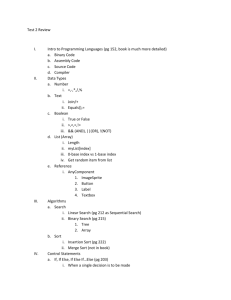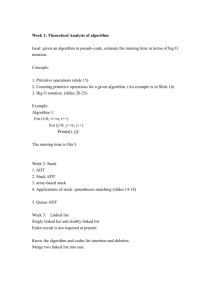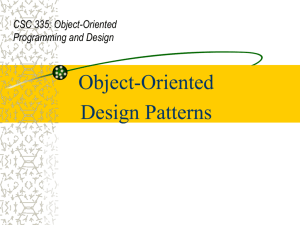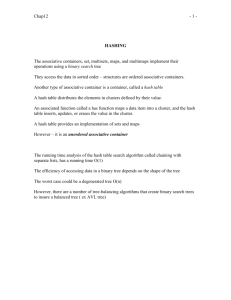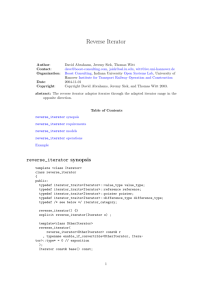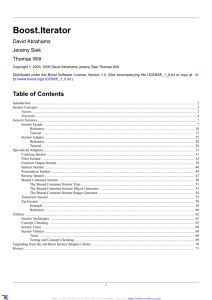Information on Midterm #1
advertisement
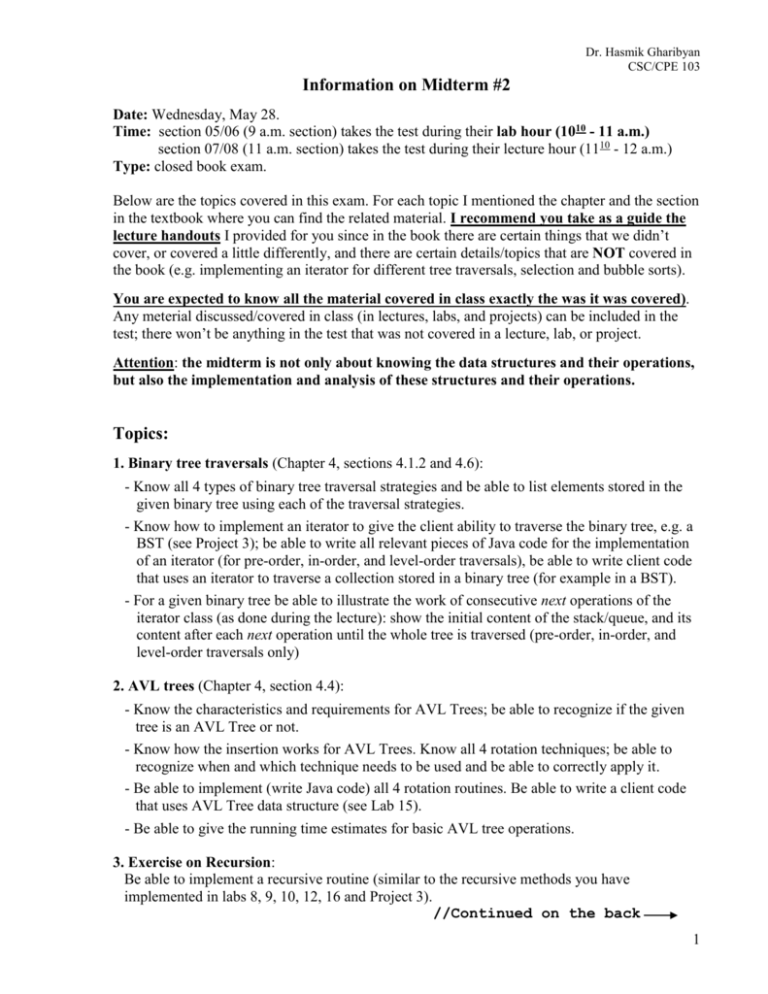
Dr. Hasmik Gharibyan CSC/CPE 103 Information on Midterm #2 Date: Wednesday, May 28. Time: section 05/06 (9 a.m. section) takes the test during their lab hour (1010 - 11 a.m.) section 07/08 (11 a.m. section) takes the test during their lecture hour (1110 - 12 a.m.) Type: closed book exam. Below are the topics covered in this exam. For each topic I mentioned the chapter and the section in the textbook where you can find the related material. I recommend you take as a guide the lecture handouts I provided for you since in the book there are certain things that we didn’t cover, or covered a little differently, and there are certain details/topics that are NOT covered in the book (e.g. implementing an iterator for different tree traversals, selection and bubble sorts). You are expected to know all the material covered in class exactly the was it was covered). Any meterial discussed/covered in class (in lectures, labs, and projects) can be included in the test; there won’t be anything in the test that was not covered in a lecture, lab, or project. Attention: the midterm is not only about knowing the data structures and their operations, but also the implementation and analysis of these structures and their operations. Topics: 1. Binary tree traversals (Chapter 4, sections 4.1.2 and 4.6): - Know all 4 types of binary tree traversal strategies and be able to list elements stored in the given binary tree using each of the traversal strategies. - Know how to implement an iterator to give the client ability to traverse the binary tree, e.g. a BST (see Project 3); be able to write all relevant pieces of Java code for the implementation of an iterator (for pre-order, in-order, and level-order traversals), be able to write client code that uses an iterator to traverse a collection stored in a binary tree (for example in a BST). - For a given binary tree be able to illustrate the work of consecutive next operations of the iterator class (as done during the lecture): show the initial content of the stack/queue, and its content after each next operation until the whole tree is traversed (pre-order, in-order, and level-order traversals only) 2. AVL trees (Chapter 4, section 4.4): - Know the characteristics and requirements for AVL Trees; be able to recognize if the given tree is an AVL Tree or not. - Know how the insertion works for AVL Trees. Know all 4 rotation techniques; be able to recognize when and which technique needs to be used and be able to correctly apply it. - Be able to implement (write Java code) all 4 rotation routines. Be able to write a client code that uses AVL Tree data structure (see Lab 15). - Be able to give the running time estimates for basic AVL tree operations. 3. Exercise on Recursion: Be able to implement a recursive routine (similar to the recursive methods you have implemented in labs 8, 9, 10, 12, 16 and Project 3). //Continued on the back 1 Dr. Hasmik Gharibyan CSC/CPE 103 4. Hash Tables (Chapter 5, sections 5.1-5.5): Know the main concepts of a hash table arrangement. Know what a hash function is and how to compute it for different types of keys: (i) for integer keys, (ii) for string keys. Be able to implement (code) the private hash method inside a class implementing a Hash Table ADT. a) Hash Tables with separate chaining. - Be able to give the implementation details of a class defined for such tables – know what the instance variable should be, what the constructor should do. - Be able to implement (write Java code) basic operations: insert, delete, find (private hash method included), as well as other operations on a collection (see Lab 13). - Be able to illustrate the work of consecutive insert operations on a given example. - Be able to implement an iterator class for hash table with separate chaining (see Lab14). - Be able to give the running time estimates for basic operations. b) Hash Tables with open addressing - Know the problems of this type arrangement: agreements/rules for tablesize, rehashing. - Be able to give the implementation details of a class defined for such tables – know what inner classes you need, what instance variables should be, what the constructor should do. - Be able to implement basic operations: insert, delete, find (private methods findposition, hash, and rehash included), as well as other operations on a collection (see Project 4). - Be able to illustrate the work of consecutive insert operations on a given example using (i) linear probing, and (ii) quadratic probing. - Be able to implement an iterator class for hash table with open addressing (see Project 4). - Be able to give the running time estimates for basic operations. 6. Simple sorting algorithms (Chapter 7, sections 7.1 - 7.3) For bubble sort and insertion sort algorithms: - Be able to illustrate the work of each algorithm on a given list (show the content of the list at any point during algorithm’s work). - Be able to write Java code to implement each algorithm. For each of 3 simple sorting algorithms: selection sort, bubble sort, and insertion sort: - Be able to give the order of the algorithm. - Be able to identify the best, worst and average cases, give and explain the running time estimates for each of these cases. In regards to simple sorting techniques: - Know what an inversion is. - Be able to recognize/point out all inversions in the given list. - Know the average number of inversions in a list. - Know the lower bound for Simple Sorting Algorithms 2
